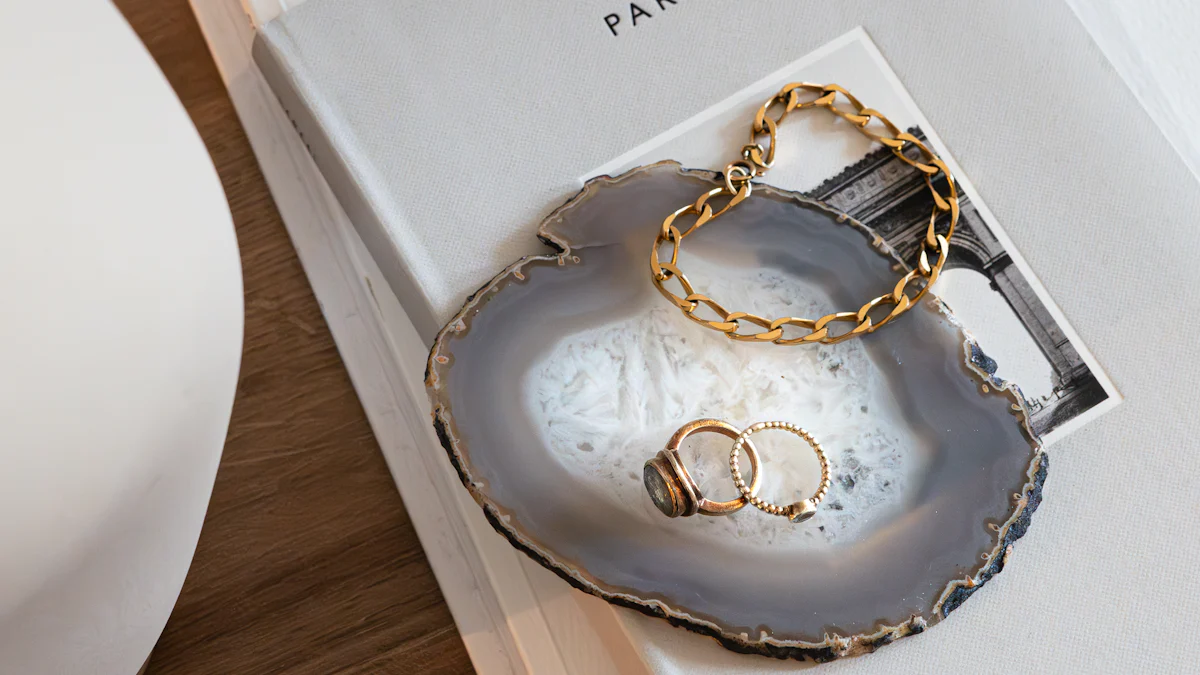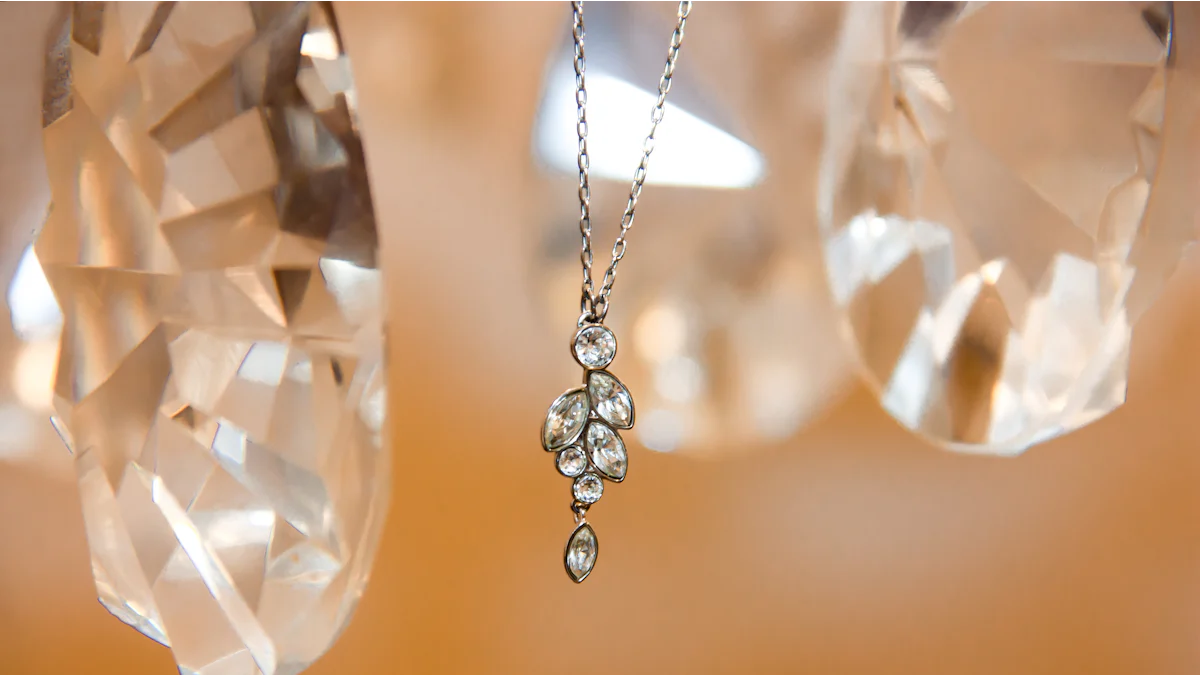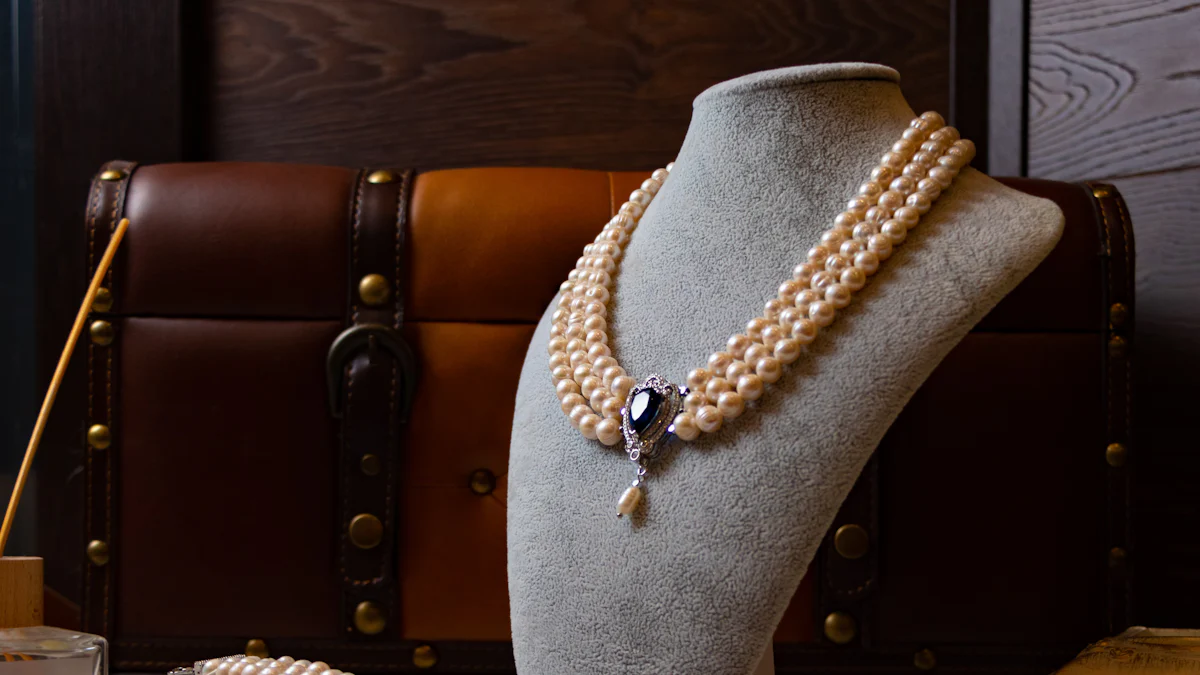Guide to Understanding T.W. Diamond in Jewelry

When shopping for diamond jewelry, you’ll often come across the term T.W. diamond. This stands for "Total Weight," which refers to the combined weight of all diamonds in a piece. It’s a key factor in understanding the value of jewelry, especially for items like a diamond engagement ring. Knowing the T.W. helps you assess whether the piece meets your expectations in terms of size and brilliance. For example, high-quality diamond engagement rings often balance T.W. with other factors like cut and clarity to create stunning designs that catch the eye.
What Does T.W. (Total Weight) Mean in Diamond Jewelry?

When you’re exploring diamond jewelry, you’ll often see the term T.W., or Total Weight. This concept plays a crucial role in understanding the overall value and design of a piece. Let’s break it down step by step.
Definition of T.W. Diamond
T.W., short for Total Weight, refers to the combined weight of all diamonds in a piece of jewelry. Whether it’s a single diamond or multiple stones, their total weight is measured together. For example, if a ring features several smaller diamonds, their weights are added up to calculate the T.W. This measurement helps you understand the overall size and presence of the diamonds in the jewelry.
It’s important to note that T.W. doesn’t just apply to diamonds. In some cases, it can include other gemstones in the piece. However, when you see “T.W. diamond,” it specifically refers to the total weight of all diamonds.
How Total Carat Weight is Measured
The weight of diamonds is measured in carats, with one carat equaling 0.200 grams. To determine the total carat weight of a piece, jewelers add up the individual carat weights of all diamonds. For instance, if a bracelet has ten diamonds, each weighing 0.10 carats, the total carat weight would be 1.00 carat.
This measurement is precise, as carats are divided into 100 points. A diamond weighing 0.25 carats, for example, is often referred to as a “25-point diamond.” Understanding this system helps you evaluate the size and value of the diamonds in your jewelry.
Common Abbreviations for Total Carat Weight in Jewelry
When shopping for diamond jewelry, you’ll encounter various abbreviations that represent total carat weight. These include:
- CTW: Carat Total Weight
- TW: Total Weight
- CTTW: Carat Total Weight (used interchangeably with CTW)
- DTW: Diamond Total Weight
These abbreviations are commonly used on jewelry labels and descriptions. They provide a quick way to identify the total weight of diamonds in a piece. For example, a necklace labeled “1.50 CTW” means the combined weight of all diamonds is 1.50 carats.
By familiarizing yourself with these terms, you can make more informed decisions when selecting diamond jewelry. Always check the label or ask the jeweler to clarify if you’re unsure about the total carat weight.
T.W. vs. Carat Weight: Understanding the Differences

When shopping for diamond jewelry, you might wonder about the difference between T.W. and carat weight. These terms often appear on labels, but they mean different things. Understanding how they differ can help you make smarter choices when selecting your jewelry.
What is Carat Weight in Diamonds?
Carat weight measures the weight of a single diamond. One carat equals 0.200 grams, and jewelers often break it down into 100 points for precision. For example, a diamond weighing 0.50 carats is a 50-point diamond. Carat weight plays a big role in determining a diamond’s size and value. Larger diamonds with higher carat weights are rarer and often more expensive.
You’ve probably heard about how diamond carat affects price. A diamond’s price doesn’t increase linearly with its carat weight. Instead, larger diamonds cost significantly more because of their rarity. This makes carat weight one of the most important factors to consider when evaluating a single diamond.
Relationship Between T.W. and Carat Weight
T.W., or Total Weight, combines the carat weights of all diamonds in a piece of jewelry. If a ring has multiple diamonds, their individual carat weights are added together to calculate the T.W. For example, a ring with three diamonds weighing 0.30, 0.20, and 0.10 carats would have a T.W. of 0.60 carats.
The key difference lies in focus. Carat weight refers to a single diamond, while T.W. represents the combined weight of all diamonds in a piece. This distinction matters because a piece with a higher T.W. might feature several smaller diamonds rather than one large stone. Knowing this helps you evaluate the overall design and value of the jewelry.
Examples: Comparing Single Diamonds and Multi-Stone Pieces with the Same T.W.
Let’s look at an example to make this clearer. Imagine two rings, each with a T.W. of 1.00 carat. The first ring features a single diamond weighing 1.00 carat. The second ring has ten smaller diamonds, each weighing 0.10 carats. Both rings have the same T.W., but their appearance and value differ.
The single-diamond ring will likely appear larger and cost more because of its higher carat weight. Larger diamonds are rarer and more valuable. On the other hand, the multi-stone ring might sparkle more because of the arrangement of smaller diamonds. This design could appeal to someone who values brilliance over size.
When comparing jewelry, consider the “four must-knows about carat.” These include the carat weight of individual stones, the T.W. of the piece, the design, and how the setting enhances the diamonds. By understanding these factors, you can choose jewelry that matches your preferences and budget.
How T.W. Impacts the Value and Appearance of Jewelry
Value: Single Large Diamonds vs. Multiple Smaller Diamonds
When it comes to value, the size and arrangement of diamonds play a big role. A single large diamond often holds more value than multiple smaller ones with the same total weight. This is because larger diamonds are rarer and more sought after. For example, a ring with a single diamond weighing 1.00 carat will usually cost more than a ring with ten smaller diamonds adding up to the same carat weight.
You might wonder how diamond carat affects price. The answer lies in rarity. As diamonds increase in size, their price rises significantly. Jewelers and buyers alike value the uniqueness of a higher carat weight. However, smaller diamonds grouped together can create a dazzling effect, offering a more affordable option without compromising on sparkle.
Appearance: The Role of T.W. in Jewelry Design
The total weight of diamonds influences how a piece of jewelry looks. A t.w. diamond piece with multiple smaller stones can create a shimmering, intricate design. This style often appeals to those who love brilliance and detail. On the other hand, a single large diamond offers a bold and classic appearance. Its size draws attention and makes a statement.
Jewelry designers use total diamond weight creatively to craft unique pieces. For example, a halo setting surrounds a center stone with smaller diamonds, enhancing its size and sparkle. This design maximizes the visual impact of the diamonds while keeping the overall carat weight balanced. Understanding how t.w. diamond impacts design helps you choose a piece that matches your style.
How Settings Enhance the Look of T.W. Diamond Jewelry
The setting of a piece can transform how the diamonds appear. Prong settings, for instance, lift the diamonds, allowing more light to pass through and increasing their brilliance. Bezel settings, which encase the diamonds, offer a sleek and modern look while protecting the stones.
Settings also influence how the total diamond weight is distributed. Cluster settings group smaller diamonds together, creating the illusion of a larger stone. This technique enhances the overall appearance without requiring a higher carat weight. When selecting jewelry, pay attention to the setting. It plays a key role in showcasing the beauty of the diamonds.
Practical Tips for Understanding TCW in Diamonds
When shopping for diamond jewelry, understanding the details behind total carat weight (TCW) can make a big difference. These tips will help you decode labels, evaluate stones, and choose designs that match your preferences.
Decoding Jewelry Labels and Abbreviations
Jewelry labels often include abbreviations that might seem confusing at first. Terms like CTW (Carat Total Weight), TW (Total Weight), and CTTW (Carat Total Weight) all refer to the combined weight of diamonds in a piece. These abbreviations are essential for understanding what you're buying. For example, a bracelet labeled "2.00 CTW" means the total carat weight of all diamonds in the bracelet is 2.00 carats.
Pay close attention to these labels. They tell you about the overall size of the diamonds but not their individual weights. If you're unsure, ask the jeweler for clarification. Knowing how to interpret these terms ensures you won’t feel overwhelmed by industry jargon.
Evaluating the Center Stone vs. Total Carat Weight
When looking at diamond jewelry, especially rings, focus on the center stone. The center diamond often holds the most value and visual impact. A ring with a 1.00-carat center stone and smaller accent diamonds totaling 0.50 carats will have a total carat weight of 1.50 carats. However, the center stone's size will likely catch your eye first.
Understanding this distinction helps you prioritize what matters most to you. If you prefer a bold, standout look, focus on the carat weight of the center diamond. If you love intricate designs, consider pieces where the total carat weight includes multiple smaller stones arranged beautifully.
Considering the Jewelry Setting and Design
The setting plays a huge role in how diamonds appear. Prong settings elevate diamonds, allowing more light to pass through, which enhances brilliance. Cluster settings group smaller diamonds together, creating the illusion of a larger stone. This design can maximize sparkle without requiring a higher carat weight.
Think about how the setting complements the total carat weight. A halo setting, for instance, surrounds a center diamond with smaller stones, making the center stone appear larger. This design balances elegance and affordability. By considering the setting, you can choose jewelry that aligns with your style and budget.
Questions to Ask When Buying T.W. Diamond Jewelry
When you're shopping for diamond jewelry, asking the right questions can make all the difference. It ensures you understand what you're purchasing and helps you avoid surprises later. Here are some essential questions to guide you through the process:
-
What Does the Total Carat Weight Represent in This Piece?
Always confirm whether the total carat weight includes all the diamonds or gemstones in the jewelry. For example, a ring labeled as "1.50 CTW" might have multiple smaller diamonds adding up to that weight. Knowing this helps you understand if the piece features one large diamond or several smaller ones. -
What Is the Carat Weight of the Center Stone?
If the jewelry has a prominent center diamond, ask about its individual carat weight. A ring with a 1.00-carat center stone and smaller accent diamonds totaling 0.50 carats will have a total carat weight of 1.50 carats. However, the center stone often holds the most value and visual impact, so it’s important to know its size. -
Are the Diamonds Natural or Lab-Grown?
Ask whether the diamonds are natural or lab-grown. Both options have their own appeal, but they differ in price and origin. Lab-grown diamonds are often more affordable, while natural diamonds carry a sense of rarity and tradition. Understanding this distinction helps you align your purchase with your preferences. -
What Are the Cut, Color, and Clarity Grades of the Diamonds?
The total carat weight gives you an idea of the size, but the quality of the diamonds matters just as much. Inquire about the cut, color, and clarity grades. These factors influence the sparkle, brilliance, and overall appearance of the jewelry. A higher grade in these areas often means a more stunning piece. -
How Does the Setting Enhance the Diamonds?
The setting plays a big role in how the diamonds look. Ask how the design enhances the total carat weight. For instance, a halo setting can make the center stone appear larger, while a cluster setting can maximize sparkle. Understanding the setting helps you appreciate the craftsmanship and design. -
What Is the Return or Exchange Policy?
Before finalizing your purchase, check the store’s return or exchange policy. This ensures you have flexibility if the piece doesn’t meet your expectations. A clear policy gives you peace of mind and confidence in your decision. -
Can You Provide Certification or Documentation?
Request certification or documentation for the diamonds. A reputable jeweler should provide details about the total carat weight, quality grades, and origin of the stones. This information not only verifies the authenticity but also adds value to your purchase.
By asking these questions, you’ll gain a deeper understanding of the jewelry and make a more informed choice. Remember, knowledge is your best tool when buying diamond jewelry.
Understanding T.W. diamond is essential when evaluating jewelry. It helps you grasp the combined weight of all diamonds in a piece, giving you a clearer picture of its value and design. By distinguishing T.W. from carat weight, you can make smarter choices that align with your preferences and budget. Always balance the visual appeal with the overall value to find jewelry that truly resonates with your style. Whether you're drawn to bold single stones or intricate multi-stone designs, knowing these details ensures a confident purchase.
FAQ
What does T.W. mean in diamond jewelry?
T.W. stands for "Total Weight." It refers to the combined weight of all diamonds or gemstones in a piece of jewelry. For example, if a bracelet has multiple diamonds, their individual weights are added together to calculate the T.W. This term helps you understand the overall size and value of the jewelry.
Pro Tip: Always check if the T.W. includes only diamonds or other gemstones as well. This ensures you know exactly what you're purchasing.
How is T.W. different from carat weight?
Carat weight measures the weight of a single diamond, while T.W. represents the total weight of all diamonds in a piece. For instance, a ring with one diamond weighing 1.00 carat has a carat weight of 1.00. However, a ring with ten smaller diamonds, each weighing 0.10 carats, also has a T.W. of 1.00 carat. The difference lies in whether you're looking at one stone or multiple stones combined.
Does a higher T.W. always mean better quality?
Not necessarily. A higher T.W. indicates more total diamond weight, but it doesn’t guarantee better quality. Factors like cut, color, and clarity play a significant role in determining the overall quality and brilliance of the diamonds. A piece with a lower T.W. but higher-quality diamonds can often look more stunning than one with a higher T.W. and lower-quality stones.
What are the common abbreviations for T.W.?
You’ll often see these abbreviations when shopping for diamond jewelry:
- CTW: Carat Total Weight
- TW: Total Weight
- CTTW: Carat Total Weight (used interchangeably with CTW)
- DTW: Diamond Total Weight
These terms all refer to the combined weight of the diamonds in a piece. Familiarizing yourself with these abbreviations helps you decode jewelry labels more easily.
Can T.W. include gemstones other than diamonds?
Yes, T.W. can include other gemstones in addition to diamonds. However, when you see "T.W. diamond," it specifically refers to the total weight of all diamonds in the piece. If gemstones are included, the label should clarify this. Always ask the jeweler if you’re unsure.
Why is T.W. important when buying jewelry?
T.W. gives you a clear idea of the total diamond weight in a piece, which helps you assess its value and appearance. It’s especially useful for comparing multi-stone designs. For example, a necklace with a T.W. of 2.00 carats might feature many smaller diamonds, while another with the same T.W. could have fewer but larger stones. Understanding T.W. ensures you make an informed decision.
How does T.W. affect the price of jewelry?
The price of jewelry depends on more than just T.W. While a higher T.W. often means a higher price, the quality of the diamonds (cut, color, clarity) and the design of the piece also influence the cost. A single large diamond with a lower T.W. might cost more than a piece with multiple smaller diamonds and a higher T.W.
Should I focus on T.W. or the center stone when buying a ring?
It depends on your preference. If you want a bold, standout look, focus on the carat weight of the center stone. The center diamond often holds the most value and visual impact. If you prefer intricate designs, consider rings where the T.W. includes multiple smaller stones arranged beautifully.
How can I verify the T.W. of a piece of jewelry?
Ask the jeweler for certification or documentation. Reputable jewelers provide details about the total carat weight, the quality of the diamonds, and whether they are natural or lab-grown. This information ensures transparency and adds value to your purchase.
What questions should I ask before buying T.W. diamond jewelry?
Here are some essential questions to guide your purchase:
- What does the total carat weight include?
- What is the carat weight of the center stone?
- Are the diamonds natural or lab-grown?
- What are the cut, color, and clarity grades of the diamonds?
- How does the setting enhance the diamonds?
- What is the return or exchange policy?
- Can you provide certification or documentation?
By asking these questions, you’ll gain a deeper understanding of the jewelry and make a confident choice.
See Also
The Importance of Three Stone Diamond Rings Explained
A Guide to Diamond Cuts for Engagement Rings
The Fascination Behind Diamond Dust Rings Unveiled

